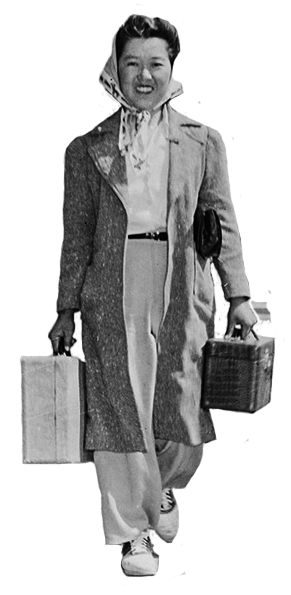
























 MANZANAR RINGO-EN MANZANAR RINGO-EN
|
See USE NOTICE on Home Page. |
These images are some of my favorite. There nearly 500 Manzanar internment images in the National Archives files. I encourage you to visit the archives and peruse the many photographs. Once you click on the icon above and are taken to the archives, type in "Manzanar" and then press "Display Results" and the images will be displayed in sets of nine. You might observe, as I did, that the internees appear rather unnaturally joyous in these pictures. I don't think that having been dislocated from their homes and businesses, forced to live in a harsh desert environment and confined to barracks with no insulation would have made them this happy. But as Jeanne Wakatsuki points out in her book, Farewell to Manzanar, Japanese Americans told each other very quietly to "Shikata ga nai" ("It must be done", or, as my Japanese friend says, "Suck it up [and get on with life]." Perhaps this is what encouraged them to put a smile on their face. Unless otherwise noted all photographs are from Dorothea Lange. Text excerpts followed by a "JWH" are from Jeanne Wakatsuki Houston & James D. Houston's book "Farewell to Manzanar" |
Art at Manzanar
K. Takumara Paintings - 1942 - 1945 Kango Takamura was an Issei artist born in Kumamoto-ken, Japan in January of 1895. He immigrated to the United States when he was seventeen years old. Takamura spent ten years in Hawaii and then went to New York after becoming interested in the motion picture industry. After a short stay at the Paramount Studios offices in Long Island he moved to Hollywood. He was working as a photo retoucher for RKO Studios in Los Angeles when Pearl Harbor was attacked by the Japanese Imperial Navy. Takamura was detained by the FBI in 1942 after offering to sell a motion-picture camera to a visiting Japanese general. He was incarcerated at Santa Fe, New Mexico for several months and then moved to a camp at Manzanar, California, where he joined his wife, daughter, son-in-law and granddaughter. He remained at Manzanar with his family until 1945. Takamura was not allowed to take photographs during his stays at Santa Fe and Manzanar but he depicted his surroundings in drawings and watercolors. He also worked as a camp sign-maker at Santa Fe and as curator for a small museum at Manzanar. When Takamura left Manzanar he returned to Hollywood and worked at RKO Studios for another twenty-five years before retiring. Takamura lived in Los Angeles until he passed away in January, 1990 at 94 years old. Kango Takamura (1895-1990) was an photo retoucher for RKO Studios in Los Angeles when Pearl Harbor was attacked by the Japanese Imperial Navy. He was detained by the FBI in 1942 after offering to sell a motion-picture camera to a visiting Japanese general. He was incarcerated at Santa Fe, New Mexico for several months and then moved to a camp at Manzanar, California, where he joined his wife, daughter, son-in-law and granddaughter. He remained at Manzanar with his family until 1945. While at Manzanar, Takamura depicted his surroundings in drawings and watercolors. He also worked as a camp sign-maker at Santa Fe and as curator for a small museum at Manzanar. After the war, he returned to Hollywood and worked at RKO Studios for another twenty-five years before retiring. The collection consists of 77 watercolor paintings produced during World War II while Kango Takamura was detained at the Santa Fe Internment Camp, New Mexico, and the Manzanar Internment Camp, California. Also included are paper mounts and one photographic reproduction of a painting. (Paintings and text courtesy of the U.C.L.A Library Digital Collection) |
|
|
|
 Akio Ujihara Painting |
 Akio Ujihara Painting |
 Akio Ujihara Painting |
 Kango Takamura Painting |
 Kango Takamura Painting |
 Kango Takamura Painting |
| Henry Murakami
was a fisherman living on Terminal Island in Los Angeles. Like
many Nisei fisherman, he was arrested and jailed, not
merely interned. He lost three purse-sein nets valued at $22,000.
His pregnant wife and four children had only forty-eight hours
to prepare to go to Manzanar. "She couldn't carry anything
except clothing... We had a three-bedroom house with a kitchen.
My wife had to abandon everything...the furniture and all of
our other furnishings, including a 1940 Plymouth...no one ever
knew what happened to my property." Yoshio Ekimoto was a Nisei, born in 1914. His family owned a forty-acre farming northern Los Angeles County. His parents had bought this farm in 1912, the year before California passed a law making it illegal for Japanese aliens to own land in the state. Ekimoto was interned at Poston, Arizona, in May 1942. He was one of the few who was able to keep accurate records of his losses. When he returned home in 1945, his farm had been completely mortgaged. He was forced to sell it to pay the mortgage. He had listed all the personal property he lost while he was interned, down to cameras, boxes of shotgun shells, and the attorney's fees he incurred (five dollars) in trying to avoid what inevitably happened to him and his family. His total losses came to $23,824 in 1942 dollar, which represents nothing of the additional personal harm suffered by him and his family, including his wife's miscarriage as a result of the internment. He was paid a total of only $692 in compensation under the 1948 Evacuation Claims Act. |
Manzanar Images courtesy of Rich McCutchan |
|
 Brochure by the Owens Valley Improvement Company. Manzanar town was founded by George and Charles Chaffey in 1910. |
|
A 1942 letter from Kosh Ando courtesy of the U.C.L.A Library Digital Collection |
|
|
Hello I just visited your site and have a report for you. The two barracks buildings from the Lone Pine airport are on the site at Manzanar. I am sure they represent only a dot of all the buildings that were once on that sloping land; however, they created a strong impact on me. I was born in 1942 and did not really know the FEAR of Japan as my elders did. I was influenced by the beautiful colors and designs of the Japanese artist and craftsmen, so much so that I continue to reproduce that idea in my own artwork on a regular basis.  On the first Sunday of May, I went with a group of artists to Manzanar. The group was originally formed by a man named Henry Fukahara who lives in Santa Monica and is now 95 years old. He was assigned to Manzanar as a young man and has gone back many times to paint the area. He is a watercolorist of great renown although he is now blinded by Macular Degeneration, such a sad thing. His friends and family want to continue this annual expedition as a tribute to Henry and all the people who once lived there. I visited the Visitors Center and thought it was very well done. The Rangers on duty recognized the pin I wore on my shirt as an "original" Takahashi bird pin, which it is, and I bought it from the artist herself many years ago. I looked up some names on the computer. Names of people that I know that were assigned to those barracks. It is an emotional thing to find their little names in the great big books. When I finally settled down to paint those two barracks, the buildings kept "talking' to me. I knew that they were not finished and the looked askew and out of place where they were. I tried and tried to paint other things, trees and hills and snow peaks and rocks, but I finally took a few moments and slapped some paint on a page. Now, two weeks later, I find that that small sketch is the one I really wanted to do. Imagine that, four families of about four each lived in one of those barracks. How did they manage. The humiliation of the latrines and those lines. The crowded laundry rooms, and those lines; the towers and shame. I think those families endured as champions. I am a descendant of Norwegians and Germans and I wonder how THEY would have gotten along in the same situation? Probably not so well. I am going to try to send you a copy of my sketch and encourage you to write more about this place and the people who were there. They are dying out and should be remembered as 110% Americans. Diane Tollefson - 2008 |
 Dian Tollefson watercolor (copyright Diane Tollefson) |
 Takahashi - Cactus Hummingbird Carved by Y. Takahashi Painted by Kiyoka Takahashi |
|
When I was a young boy, in about 1944, I remember that one of my mother's sisters lived in a place called Lone Pine. I knew that my uncle was in the army, but had no idea of what he did. When I was older, I learned that, owing to insufficient qualifications for combat duty, he was assigned as a guard at Manzanar. Ironically, my mother's best school chum in Reedley, CA, was later interned there, along with her family. I remember, from my elementary school days, the former Japanese truck farms in Tulare County - always meticulously tended and weeded - which were suddenly in the hands of whites. Somewhere in my mother's effects is a round camp badge, similar in size to an old political button, green and white, with Japanese characters scratched on the reverse side. If I can locate it, I would like for it to become part of a historic display or returned to the family of the internee whose serial number is on the front. Tom Jackson March 2008 |
|
I came to the Bishop from Ireland with my Mother when I was 6 months old. My mother was a war bride. My granddad, David S Bromley worked in Manzanar. Some of my earliest memories were of going to Manzanar with my Granddad. There didn't seem to be a lot of people left, but I always remember visiting with those who were there. One of my most vivid memories (and 1st memories) is of a very kind Japanese lady giving me a sugar cube. I thought this was the greatest thing in the world and still hold that memory close to my heart. I don't get to Bishop very often, but would love to visit Manzanar. I remember, so vividly, my Granddad speaking so highly of the people in the camp. I always felt, that he felt it was wrong. I think his emotions came out in his poetry. It's quite a legacy that I've been left with and I would love to learn as much as possible about this time in my Granddad's life. I know it affected him forever. Elizabeth Bromley Adamson October 2007 Rock Creek, Mammoth, Tom's Place |
Sign Guestbook View Old Guest Book Entries Oct 1999 - Feb 2015 (MS Word) |
 CONTACT the Pigmy Packer |
View Guestbook View Old Guest Book Entries Oct 1999 - Feb 2015 (PDF) |


































